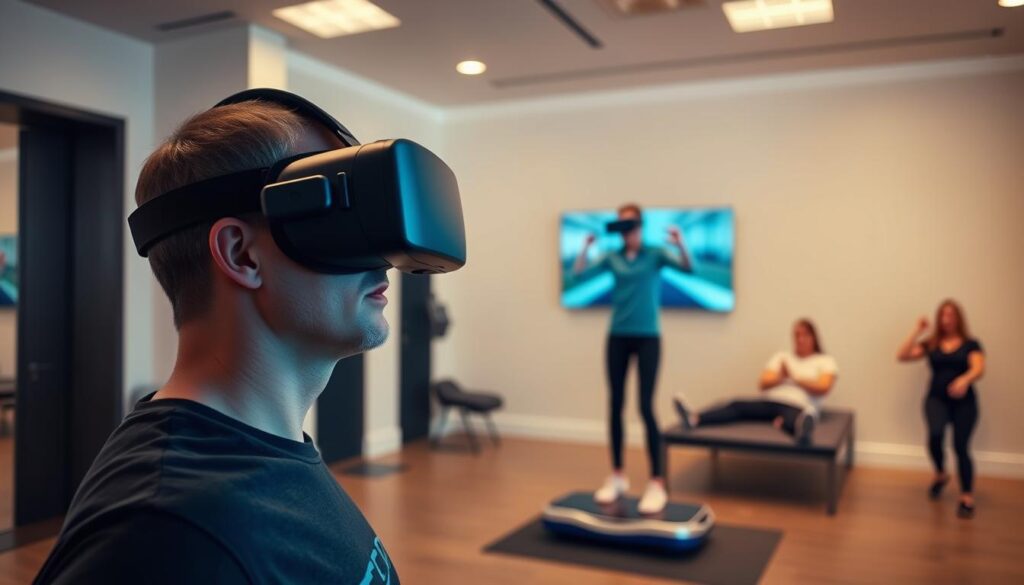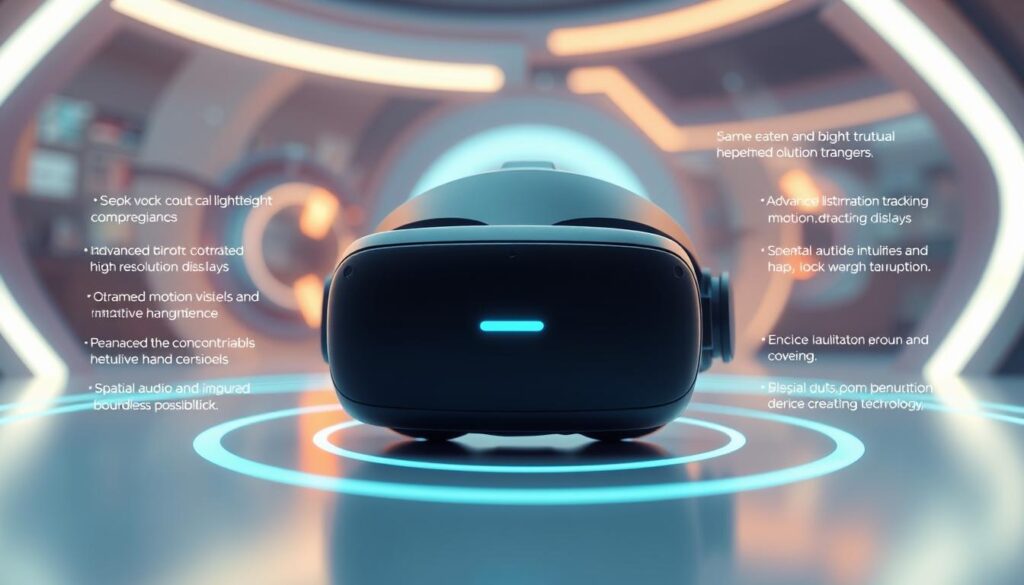Can a virtual reality headset really change how patients do rehab exercises? It turns out, yes, it can. The Oculus Quest 2 is leading the way in interactive therapy for physical rehab. It makes rehab fun and boosts recovery.
This tech uses virtual worlds to keep patients motivated and on track. It’s a game-changer for virtual reality in physical therapy. It could change how we care for patients forever.
Introduction to Virtual Reality in Physical Therapy
Virtual reality is changing physical therapy in big ways. It lets patients dive into special worlds made just for their needs. This makes therapy more fun and keeps patients motivated.
Studies show virtual reality can really help patients get better. Old ways of therapy might not keep patients interested. But, virtual reality makes therapy feel like real life, helping patients feel they’re making progress.
Rehabilitation is all about getting better, and virtual reality helps a lot. It’s becoming more popular for online therapy, helping those who can’t go to the doctor. This makes therapy more accessible and helps patients stick to their plans, leading to better results.

Overview of Oculus Quest 2 Technology
The Oculus Quest 2 is a big step forward in VR technology. It’s a self-contained head-mounted display that offers a fully immersive experience. It’s easy to use, with no need for external sensors, making it perfect for clinical settings.
This device is wireless, which makes therapy sessions more flexible and free. Patients can move around easily without being tied down by cables. The built-in 3D audio adds to the experience, making it feel more real.
The Oculus Quest 2 tracks head and body movements with six degrees of freedom. This makes it a versatile tool for therapists. It allows for personalized therapy plans that meet each patient’s needs, making therapy more effective and engaging. The Oculus Quest 2 is leading the way in using VR for rehabilitation.

Benefits of Interactive Therapy for Patient Motivation
Interactive therapy, especially with tools like the Oculus Quest 2, boosts patient motivation in rehab. It uses virtual reality (VR) to make therapy sessions fun and engaging. This turns boring tasks into exciting games.
Patients get instant feedback, which makes them feel accomplished. This boosts their motivation and makes them want to do more. Seeing their progress in VR also motivates them.
Interactive therapy also makes rehab more fun. It combines games with therapy, keeping patients focused on their goals. This approach leads to better results and more successful recoveries.
Oculus Quest 2 in Interactive Therapy and Patient Motivation
The Oculus Quest 2 is a game-changer in interactive therapy. It makes therapy more fun, boosting patient motivation. This leads to better results in rehabilitation programs.
Creating Engaging Experiences for Patients
Virtual reality with the Oculus Quest 2 makes therapy fun. It turns boring exercises into exciting adventures. Patients enjoy it more than old-school therapy.
This fun approach keeps patients excited about their recovery. It makes them look forward to therapy sessions.
Improving Adherence to Rehabilitation Programs
The Oculus Quest 2 makes patients want to stick with therapy. It lets them choose activities they like. This makes therapy feel more like a hobby than a chore.
Patients are more likely to follow their therapy plans. This leads to better results and a stronger sense of motivation.
Common Conditions Treated with Oculus Quest 2
Oculus Quest 2 technology has changed how we treat different conditions in therapy. It’s great for treating many health issues. People with musculoskeletal problems, like shoulder injuries and rotator cuff tears, see big improvements.
It also helps those with neurological issues and balance problems. The Oculus Quest 2 lets patients practice real-life scenarios. This makes therapy more fun and effective.
Oculus Quest 2 is very flexible. It can be customized for many patients. This means it can help a lot of people in different ways. It’s a big step forward in therapy.
Enhancing Rehab Outcomes with Virtual Reality
Virtual reality is changing the game in rehab. It creates immersive experiences that boost motor skills and functionality. Clinicians see big gains in strength and coordination, making rehab more effective.
Measurable Improvements in Motor Skills and Functionality
Studies show virtual reality makes a real difference in motor skills. Patients get better at balance and coordination through fun exercises. These exercises are like real-life activities, helping patients practice for everyday use.
Real-World Applications within Therapy Sessions
Virtual reality in therapy does more than just exercises. It lets therapists create programs tailored to each patient. This keeps patients engaged and motivated, leading to better results.
By using real-life scenarios, patients learn to apply what they’ve learned in therapy. This makes their rehab efforts more practical and effective.
Case Studies: Success Stories using Oculus Quest 2
Recent studies show how Oculus Quest 2 is changing patient rehabilitation. These stories highlight how virtual reality can motivate patients and improve therapy. They also show how it can lead to better results in rehabilitation.
Patient Experiences in Rehabilitation
Patients in rehab with Oculus Quest 2 have great things to say. They feel more into their therapy sessions. The VR makes therapy fun, not a task.
Many patients also feel better mentally. They get excited about doing exercises and stay focused. This shows how important it is to use new tech in rehab.
Comparative Outcomes with Traditional Therapeutic Approaches
Studies compare Oculus Quest 2 to old-school therapy. Patients using VR do better in their recovery. This shows VR can make therapy more effective.
Looking at many cases, VR users get stronger muscles and better motor skills. This makes a strong case for using VR in therapy more often.
Challenges of Implementing Oculus Quest 2 in Therapy
Using Oculus Quest 2 in therapy comes with big challenges. One major issue is the cost of buying these devices. This can be too expensive for many healthcare places. They might find it hard to afford it, especially when they are already short on resources.
Training staff is another big problem. To use Oculus Quest 2 well, healthcare workers need special training. This training takes time and money, which can be hard for healthcare providers to find.
Getting access to technology is also a challenge. Some patients might not have the chance to use Oculus Quest 2. This makes it hard for them to join in with the therapy that uses it.
There are also worries about safety and comfort when using Oculus Quest 2. Healthcare providers need to make sure patients feel okay when they use it. They have to deal with any discomfort that might make the therapy less effective.
| Implementation Challenges | Description |
|---|---|
| Financial Costs | High initial investment for devices that may deter healthcare facilities. |
| Staff Training | Need for comprehensive training programs to ensure effective use of the technology. |
| Access Issues | Digital divide impacting technology access for some patients. |
| Device Safety | Concerns about user comfort and potential physical safety risks. |
Future of Virtual Reality in Physical Therapy
Virtual reality (VR) is changing physical therapy, opening up new ways to help patients. Healthcare experts see VR’s benefits and are excited for the future. They believe it will make patient care better.
New ideas in VR will change how we treat patients. It will become a key part of physical therapy. This change will make treatments more effective and personalized.
Innovative Developments on the Horizon
New tracking systems will make VR therapy even better. These systems will help create treatments for more conditions. They will meet the specific needs of each patient.
VR will also become more realistic. Patients will be able to practice real-life activities in a safe space. This will boost their motivation and help them recover faster.
As VR proves its worth, more doctors will use it. This will make healthcare systems more connected. VR will become a key part of helping patients get better.
Conclusion
In this article, we’ve seen how Oculus Quest 2 is changing therapy. It brings new life to physical therapy by making it more fun and engaging. This technology helps patients stay motivated and improves their recovery.
Studies show that VR is getting better and will be used more in therapy. This is a big change for physical therapy. It makes therapy more interactive and helps patients get better faster.
As we look ahead, technology will play a bigger role in therapy. Oculus Quest 2 is leading the way. It helps therapists create better experiences for patients, making recovery more effective and rewarding.





